The evolution of the television set
Once the 1930s hit, television technology started to grow. Although radio (and television) stations in the United States experimented with tv technology later in the 1930s, in 1936, the British Broadcasting Corporation (BBC) made waves across the pond. From sports to cartoons, the BBC produced TV shows to those able to watch up until 1939 when World War II broke out.
The Evolution of Television Technology Through the Decades
Since the 1950s, television has played an integral role in people’s lives. After all, it has both reflected and shaped our cultural values, although it has sometimes been criticized for its alleged negative influences on children. At other times, television has also been lauded for its ability to create a standard viewing experience for people.
Some of the world’s most major events, such as the assassination of President John F. Kennedy, the Space Shuttle Challenger disaster in 1986, and the 9/11 terrorist attacks, have played out before our eyes on television, uniting people in a shared tragedy, yet offering hope. Currently, internet technology and satellite broadcasting is paving the way for the future, changing the way we view content. Indeed, television is one of the foremost important inventions of the 20th century.
Television is a powerful medium that has changed the way we see the world. From the fuzzy image and poor sound quality we saw in its early days, to the hundreds of channels in high definition and stereo sound we see today, television has come a long way.
As we look at how the evolution of television technology weaves its way through the decades, it’s easy to see how something so simple — pictures matched with words — affects everyone in the world, in one way or another. Additionally, with such a large departure of the evolution of television technology from decade to decade, it comes with no surprise to understand that television technology and communication through television-adjacent products (like video game sets) shape where we are going as developed people into an age of connectedness.
Evolution of Television Technology: Pre-1930s
It’s fascinating to think that the television, even before it became a television, evolved from wireless (or radio) telegraphs through the transmission of radio messages like Morse code. Although the radio was still in popular use pre-1930, the 1920s was when the foundations of the television happened.
Although there are multiple people who could be tipped as the inventor of the television, one of the main reasons why the television is what it is today is because of cathode ray tubes implanted in a camera .
At the turn of the decade , between 1927 and 1929, engineers and scientists continued to work on how to produce a picture transmitted in a moving image through an electronic camera tube.
Evolution of Television Technology: 1930s – 1950s
Once the 1930s hit, television technology started to grow. Although radio (and television) stations in the United States experimented with tv technology later in the 1930s, in 1936, the British Broadcasting Corporation (BBC) made waves across the pond. From sports to cartoons, the BBC produced TV shows to those able to watch up until 1939 when World War II broke out.
On the US side, the first commercial electronic television set , the DuMont Model 180 , was sold for $395 in 1938. A year later, the then-US President Franklin D. Roosevelt was the first president to appear on television.
Although radio was the most influential and popular technological invention throughout World War II for most Americans (and, frankly, for any civilian around the world), the 1940s was when the television was being introduced more and more to the public for consumption.
Nearing the 1950s, when televisions were becoming more popular, government regulations were introduced for television stations, tv channels, and more standardized programming. And once the 1950s hit, the public was used to televisions being normalized in households around the country. Although there were baby steps at the beginning of the decade, 1954 introduced a whole new world of television to the public: color television.
Evolution of Television Technology: 1960s – 1980s
As a new decade was ushered in, more technological advances for televisions were also welcomed. Although the color television had been introduced the decade prior, due to the high price and lack of programming being recorded in color, most television owners didn’t experience the color TV advantages until the 1960s. Most TV programming finally relented and began to introduce the transition from black-and-white to color television programs in 1965.
Backing up a few years and we’ll understand that one advancement in 1962 will help one of the largest, most influential parts of human history later in 1969. In July of 1962, NASA launched Telstar — the world’s first active communications satellite. Two days after launch, it sent back to earth the first transatlantic television signal in the world. The tenuous repercussions of such was felt 7 years later when, on July 20, 1969, American Neil Armstrong would set foot on the moon — with anywhere from 600-650 million people watching the landing on television.
After that momentous occasion capping off the 60s, just a few years later in 1972, there were nearly 9 million color television sets sold, surpassing the amount of sales of black-and-white television sets.
And with all of the color television sets available and sold, many of those people who had purchased a television set were able to view another significant event, this one most likely in color: the wedding of Prince Charles and Lady Diana Spencer in 1981, which was watched by 28 million people. And a few years later in 1985 in the U.S., a little over two-third of the households in the country had cable service readily available.
Evolution of Television Technology: 1990s – 2010s (and Beyond)
Once the 1990s began, television technology seemingly continued at hyperspeed. Whether it was HDTV standards being set six times the resolution of the conventional SDTV format (in 1994) to television companies collaborating to produce large, flat-screen TVs (in 1997 with Sony and Sharp), it was a decade of improvement in the television industry.
However, once Y2K happened, then the evolution of television technology truly took hold. In 2001, the switch from analog to digital began; meanwhile, in 2003, some satellite and cable companies began to offer the feature to record live programs (hello, DVR!). Then, just a few short years later in 2009, smart televisions were introduced, with TV watchers able to surf the Internet, utilize apps, and — of course — watch TV shows, movies, and sports , with LED televisions becoming bestsellers a few years later, bettering LCD and Plasma TVs.
Additionally, in 2016, the introduction of 4K and 8K resolution televisions have brought on an even larger boom into how realistic television and movies can look. This includes adjacencies such as virtual reality (VR) and 4D televisions. Although both VR and 4D aren’t as popular in 2023 as they possibly could have been, the evolution of the technology continues to spur innovation in the television industry.
Key Takeaways of Television Technology
Not only was the evolution of television technology spurred on by engineering advances and scientific discoveries at its genesis, there are ways that television and media have improved over the decades, and, truly, over the past century .
Part of the enjoyment of watching television is to experience the history of television, all the while having it at your fingertips. To protect the investment and the integrity of your television, and to enhance the quality of the picture (at the same time making sure that your neck pain goes away) because the television is situated at its best angle, a MantelMount pull down TV mount is the investment you will want to make.
Evolution of tvs

Rose Clare Leonard watches the screen, which reproduces a 5×7 image, as she tunes in at the first public post-war showing at a New York department store, Aug. 24, 1945. This television set, retailing for $100, is reported the first moderately priced receiver manufactured in quantity.
Chair-side console

Violet Assad watches the Louis-Conn fight on Emerson Radio’s new chair-side console television receiver with ten inch screen. It will retail for approximately $250. A large-view (ten-inch screen) console model television set and a small table model with a seven-inch screen were at press previews in New York, June 21, 1946. One of the features of the new television models is screen visibility which exposes the television image to be clearly seen by many onlookers in a room, either sitting or standing.
Du Mont Deluxe
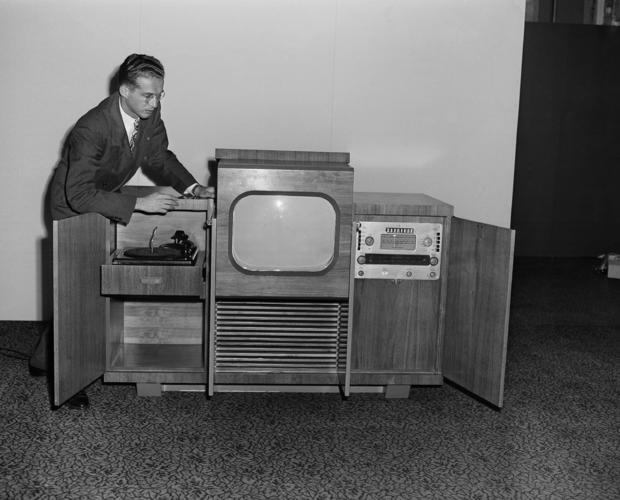
Irwin Cochen is shown looking over the Hampshire Model Du Mont Deluxe television receiver in New York, Oct. 11, 1946. It has a twenty inch direct view tube which serves as the screen itself. The screen itself is retractable.
Tabletop

An American family watches a tabletop radio television in 1948. By 1954, more than half of American households had a television. By 1962, 90 percent had one.
“Modern Picture Tube”
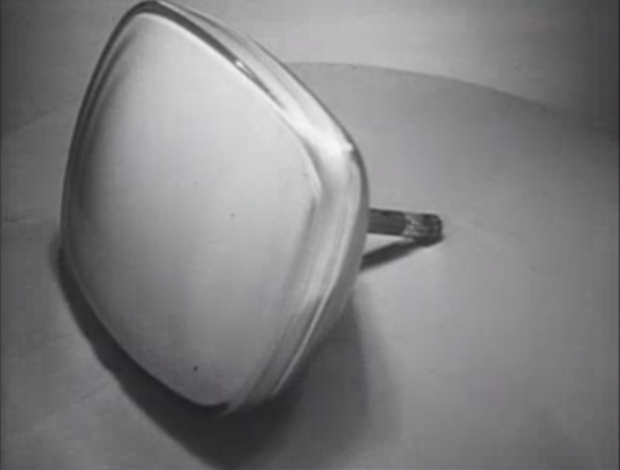
An RCA picture tube from 1956. Vacuum-tube technology was the dominant technology into the 1970s and meant that televisions were large and heavy.
Larger screen

Violet Pelkey tunes a television in the village of Plymouth, Vt., in the same building where Calvin Coolidge was born, Aug. 19, 1953. Service to rural towns led the early development of cable television to improve unsatisfactory aerial transmission.
Kuba Komet
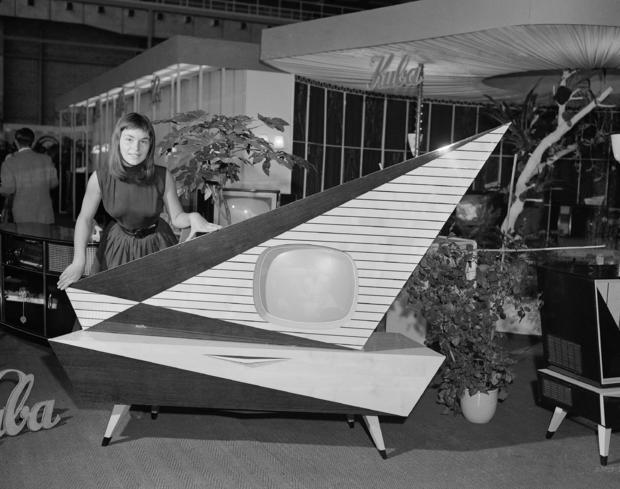
A television screen is inset into an avant-garde cabinet for canned music called the “Kuba Komet” at the Radio and Television Exhibition in Frankfurt, West Germany, Aug. 5, 1957. As well as the television set, the Komet houses a radio, a record player and a tape recorder. The upper part of the assembly swings on a vertical axis to face any direction.
Remote control

Eight-month-old Andrea Whalen holds trick rabbit that causes the television set to change channels when bunny is pressed and squeaks, Feb. 6, 1961. The television set has a remote control device which is evidently activated by squeak from rabbit. The first wireless television remote control was developed in 1955.
Antennae

Rooftop antennae receive television transmissions in June 1973. Over the years antennae and satellite dishes have come and gone depending on changing technology and popularity.
Changing sizes
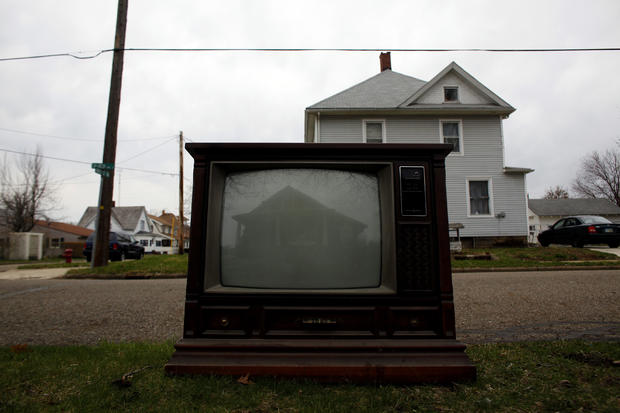
A house is reflected on the screen of a discarded television in Beach City, Ohio April 6, 2011. The invention of liquid crystal display (LCD) in 1983 meant that the size (and weight) of televisions could trim down.
Prized possession worldwide
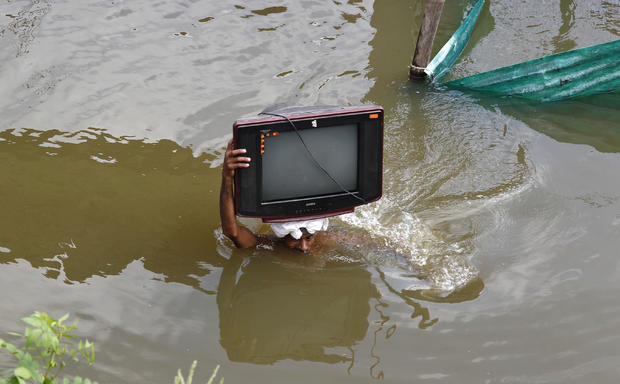
A man carries his television set to a safer place after heavy monsoon rains caused a rise in the water levels of the river Ganges in the northern Indian city of Allahabad, Aug. 1, 2013. As the cost of televisions declined their popularity around the world soared. By 2009 78 percent of households worldwide had a television.
Discarded for a newer model

An employee arranges discarded televisions at a newly opened electronic waste recycling factory in Wuhan, Hubei province, China, March 29, 2011. According to the U.S. Environmental Protection Agency (EPA), e-waste is the fastest growing commodity in the waste stream, with a growth rate five times that of other parts of the business such as industrial waste. The burgeoning middle classes in fast-growth China and India mean there are more computers and mobiles, adding to e-cycling growth.
A model for every household

A man walks past televisions for sale at a Best Buy store in New York City, Nov. 23, 2010. LCD (liquid crystal display) have been steadily phasing out cathode ray tube display televisions since their invention in 1983.
Curved screen

Japan’s electronics giant Seiko Epson unveils a prototype model of the flexible LCD display, a 3.8-inch full color super slim VGA panel in 0.1mm thickness at a flat panel display trade show in Yokohama, Japan, Oct. 3, 2003. The very thin LCD display can flex to form a curved screen.
In-flight entertainment
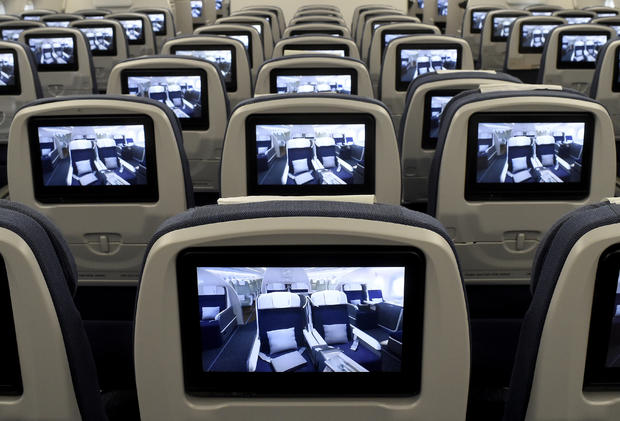
TV screens, installed on board of an Airbus A350 XWB flight-test aircraft are pictured during a media-day at the German headquarters of aircraft company Airbus in Hamburg-Finkenwerder, April 7, 2014.
Stadium-sized displays

A person stands on the screen stage during a public viewing event of the 2014 World Cup soccer match between England and Italy in Mangaratiba, Brazil, June 14, 2014. The world’s largest television display is and 172,220 square feet (16,000 m 2 ) in Harmony Times Square in Suzhou, China.
Flat screen
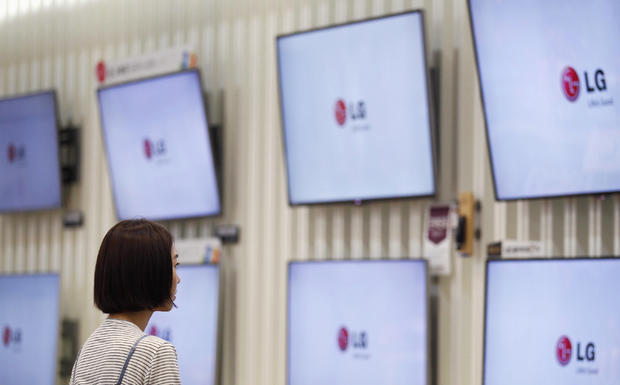
A customer looks at LG Electronics’ television sets, which are made with LG Display flat screens, at its store in Seoul, South Korea, July 22, 2014. South Korea’s LG Display Co Ltd, the world’s biggest maker of liquid crystal displays, reported April-June operating profit of 163 billion won ($159.20 million), compared with 366 billion won a year earlier and a 94 billion won in the first quarter. Picture taken July 22, 2014.
Ultra HDTV

A model stands in front of Samsung’s 110 inch Ultra HDTV at the 2013 International CES at the Las Vegas Convention Center on Jan. 8, 2013 in Las Vegas, Nev. Introduced in 1998, HDTV has become the most popular form of television.
Smartphone display

An official shows a Plastic OLED (POLED) display used in LG Electronics’ curved-screen smartphone “G Flex” during a media event to unveil the new product at the company’s headquarters in Seoul, South Korea, Nov. 5, 2013. The G Flex has a 6-inch plastic OLED display that curves inward from top and bottom.
]]>